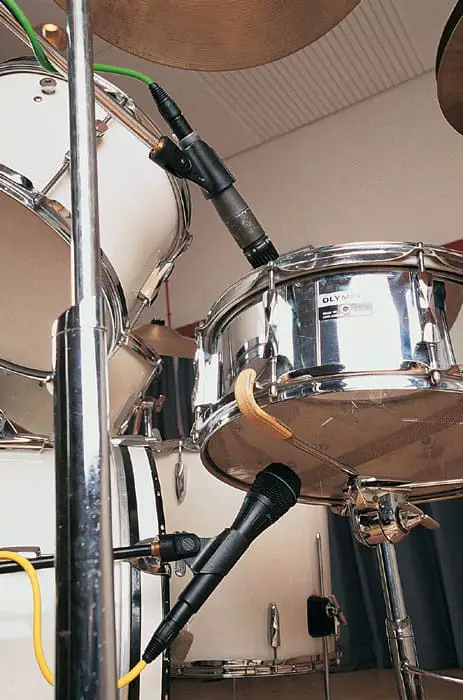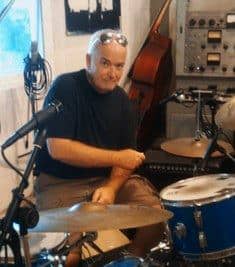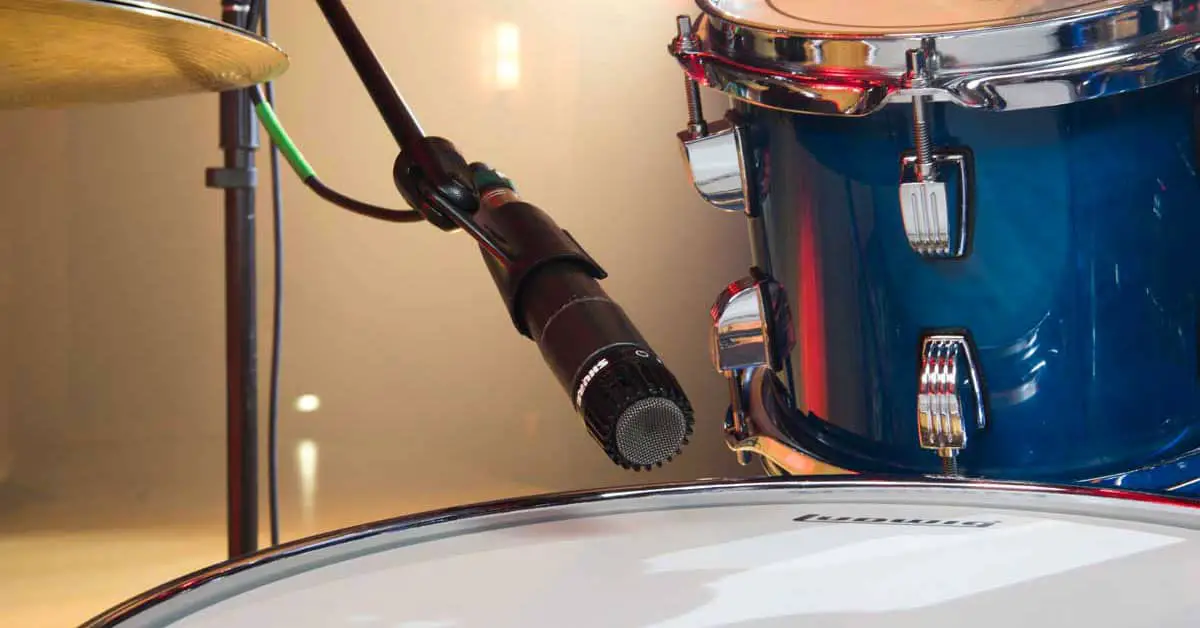Not too many other instruments get as much attention in Recording as the Snare Drum does. It can make or break the recording and set the whole feeling and be the voice for a track whatever the genre. The best techniques are done with Mic Placement. How to Mic a Snare Drum?
2 Mic Placement Technique:
Top Mic-Dynamic Cardioid-3 fingers off the Rim aimed away from Hi-Hat towards Center of the Drum
Bottom Mic-Dynamic Cardioid-3 fingers off the Springs aimed at the Center of the Drum
Used with 2 Overhead Small Condenser Mics-using an X/Y Configuration-approx. 6ft over Snare
Being a drummer I know how the Snare can deliver the crisp punch, crack, and pop that can drive your tune to the stars or leave it behind in the world of mediocracy. Mic it right!
The Importance of the Snare Drum In Music
There is no doubt about it when it comes to which drum on a kit is the focal point and creates the most dynamics and attention it’s the Snare Drum for sure. In some genres more so than others. As a Blues player, it demands to be highlighted with
The most common musical form of blues is the 12-bar blues. The term “12-bar” refers to the number of measures or musical bars, used to express the theme of a typical blues song.
Nearly all blues music is played to a 4/4 time signature, which means that there are four beats in every measure or bar and each quarter note is equal to one beat. Uncomplicated and simple yes but if not pronounced it doesn’t come across and sound good.
The most important part of playing Blues is keeping time and the focal point of the time is the sequence Kick, Cymbal, and the Snare, with all emphasis highlighted by the Snare Drum. The Snare Drum is critical and needs to be accepted and pronounced. Hi-Hop and Rock too.
A flat-sounding Snare Drum that is not tuned or miked properly will directly affect the rest of the band’s sound and recording making it dull and lifeless.
Snare drums are easily the most recognizable voice in the drumkit. Some studio drummers use a different snare for every song, in order to change the overall voice of the kit, which proves this and shows this theory in action. Some Drummers have signature snare sounds that identify them immediately, whereas others aim for less-distinct tones that blend into the music.
Different parts of the Snare Drum have the ability to change the sound of the Snare by adjustments such as the lugs or tension rods. Rims and Hoops are made from a different material that will allow the drum to ring longer, produce more overtones, and yield greater snare sensitivity.
When you Mic a Snare Drum You need to be able to find some of those frequencies and subtle noises and nuances. The Snare is more than just a Drum.
Snare Mic Placement
Capturing the Snare Drum and isolating it from the rest of the kit is a tricky endeavor that relies on the best quality microphone positioning and placement. Whether recording in the Studio or playing Live on stage the Snare Drum is usually miked by two microphones one on top and one on the bottom.
Most of Snare’s sound comes from the top Mic which is typically a Dynamic type of Microphone. If using a bottom mic it is also a Dynamic that can handle the SPLs or sometimes a Condenser that is used to pick up special sounds like a snap coming from the snares.
1 Microphone Placement Technique
I Dynamic Cardioid Microphone-3 fingers off the Rim- facing away from the Hi-Hat aimed at the Center of the Drum. A simple easy way to get a fine recording.
1 Dynamic Cardioid Mic blended with a Small Diaphram Condenser Mic such as AKG C 451 B Small-Diaphragm Condenser Microphone This Technique for miking a Snare Drum is very popular in Recording Studio and in Popular Music. For a more professional way.
1 Condenser Mic-If you’re looking for more nuance and color rather than power and volume then try using a Condenser Mic from the Top. This will give you a brighter open quality sound than the Dyanamic Mic will. Something like AKG Pro Audio C414 XLII Vocal Condenser Microphone, Multipattern Using the Pad on the microphone will allow you to handle the SPL that the Dynamic mic will. Mic Placement is 6-8 inches off the Snare head. Keep away from the High-Hat as much as possible. If you’re in a good space for recording
2 Microphone Placement Technique: The Most Professional Studio Technique
The Top Snare Mic is usually positioned between the High-Hat and the first Rack Tom. In this position, it can minimize the bleed from the other drums plus keep it out of the Drummer’s way. Positioning the Mic closer to the Snare head will also minimize bleeding from the rest of the drums.
The problem with that is while minimizing bleed it might start to muddy up the sound. If the Mic’s head is too close it exaggerates the lower frequencies and destroys the sounding darker and less open.
Lifting the capsule up and pointing it down aiming towards the edge of the drum head will emphasize the Overtones.
Angling it toward the center of the Snare head will emphasize the Attack.
Moving the Mic outside the Snare’s Rim will create a Dryer Sound with less Ring.
The Bottom Snare Mic can be placed directly closely under the Snare Drum without touching the snares underneath. Again, Close enough to minimize bleeding but not in danger of hitting the snares. Adding a bottom mic can add extra brightness and snap to the Snare Drum without needing EQ to the mix. It’s not completely needed. You can mic just from the top for a great result.
2 Snare Mics and 2 Overhead Microphone Technique
Top Microphone-Dynamic Cardioid Shure SM57-LC Cardioid Dynamic Microphone Mic-3 fingers off the rim aim at a 45-degree angle
Bottom Microphone-Dynamic Cardioid (Shure SM 57) Mic -3 fingers off the rim at a 45-degree angle
2 Overhead Mic–Rode NT5 Compact Cardioid Condenser Microphone, Single-Miked in an X/Y Configuration approx 6ft over the Snare Drum.
How to Mic a Saxophone
Best Snare Mic
 The Snare Drum has a significant role in propelling your kit into the force of the music you play. It needs a microphone that can handle that spotlight and makes it sounds its best Live on stage or in a Recording Studio.
The Snare Drum has a significant role in propelling your kit into the force of the music you play. It needs a microphone that can handle that spotlight and makes it sounds its best Live on stage or in a Recording Studio.
There are some options and decisions to make when it comes to recording snare, among them are mic selection, mic placement, preamp choice, processing EQ and compression, reverb, and other recording tricks but the most important to playing Live or Recording is the Snare, Player, the Microphone and Placement.
There is a lot of a variety of sounds and noises coming from a Snare Drum played by a good Drummer and picked up near those sweet spots that are on every acoustic instrument.
Different kinds of snare drum sounds, from big and fat to thin and ringing and everything in between. You just got to find them and then capitalize on them. That all comes with experimenting on placement and Mic position. Sweet spots are especially important on a Snare Drum.
Factors to Consider For Picking A Snare Mic
Condenser or Dynamic– A dynamic usually picks up less ambiance and leakage from other sound sources than the more sensitive condenser mics. Ribbon mics are challenging on snare drums because of the proximity effect from other drums and their ear lobe, making them hard to work with.
Directional pattern — In a Home Recording setting, I would prefer to use directional mics like cardioids and hyper-cardioids to avoid leakage from toms, hats, and cymbals. In a controlled room maybe with an Engineer maybe you could afford something else.
Microphone Size -for obvious reason. The Snare Mic is going to come close to the other mics and drums in the kit. The player has to be comfortable with runs and working around the placement and mic without hitting anything.
Headroom -The Snare can make some big exploding noises that create a need for more Headroom which is a measure of the mic’s ability to accept the high sound pressure level (SPL) of a snare drum without distorting or clipping.
Snare Mics are used Live and in Studios
Shure SM57-LC Cardioid Dynamic Microphone The Music Industries’ favorite all-time workhorse Microphone that can do it all but then you already knew that. The Shure SM57 is a fixture in the music business. You see it everywhere. In small clubs and 100,000-seat stadiums. This renowned mic is used by legendary performers and the latest up-and-comers. Its also recommended for miking the most important part of your Drum Kit your Snare.
Beyerdynamic M201 TG Classic Dynamic Hypercardioid Microphone for all Instrumental Applications
- Universal microphone for instrument miking
- Small dimensions for unobtrusive positioning
- Hypercardioid pattern with rugged construction
- An excellent choice for snare drum mic situations
Sennheiser MD 421 II Cardioid Dynamic Mic The MD 421 II is one of the best-known microphones in the world. Its excellent sound qualities enable it to cope with the most diverse recording conditions and broadcasting applications. The large diaphragm, dynamic element handles high sound pressure levels, making it a natural for recording guitars and drums. The MD 421’s full-bodied cardioid pattern and five-position bass control make it an excellent choice for most instruments, as well as group vocals or radio broadcast announcers.
Phase Alignment
When using 2 mic techniques or any technique where you are using numerous mics, you’ll have to ensure that Phase Cancellation doesn’t affect your recording. Because both mics are pointed towards each other they have to catch the wave sound pressure from the sound at the same time.
If they don’t this makes one drop out and cancel the signal. What you need to do is to flip the polarity or phase on the Bottom Mic that is miking the resonant head on the Snare. You can do it on DAW or mic pre where they are usually located.
The distance between the two mics is particularly important. Directional Cardioid mics are very likely to have a Proximity Effect while Close Miking and the closer they are to the source of what they are making like the Snare head or an amplifier the more likely that problem could be developed.

JimGalloway Author/Editor

